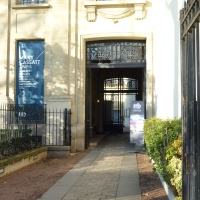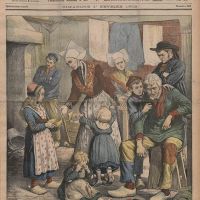I am writing this on Sunday, December 24, and all I can think about is Vincent Van Gogh. Until recently, I had not realized that he’d cut off his ear on December 23 (which in 1888 was also a Sunday), and been discovered and taken to the hospital in Arles on the morning of December 24. Christmas Day would have passed for him in a blur of pain.
Of course, Christmas in 1888 in France was not the sentimentalized orgy of family togetherness we are told to expect these days, but I can’t help wondering about the timing of this event. Vincent was lonely and his housemate of only two months was not working out. Paul Gaugin, who had been staying with Van Gogh, beat a hasty retreat to Paris on Christmas Day in the company of Vincent’s brother Theo, who had made a rushed trip to see his brother, spending less than 12 hours in Arles.
By December 31, Van Gogh was feeling better, but he was still in hospital. During his stay, he painted the high-ceilinged ward that he shared with other patients, as well as a view of the cloister with its bare winter trees and evergreen bushes.
Although the paintings look fairly peaceful, for part of his time in hospital, Van Gogh was isolated in a small hut or cabanon, where he was strapped down on a bed, all freedoms removed, which must have traumatized him.
Vincent was not allowed out until January 4, 1889, and then only for a short visit to his house on the Place Lamartine.
On January 7, he moved back into the house and started to work again. In the painting below, the Yellow House occupies the centre of the picture and has green shutters.
The Yellow House is gone now. It was destroyed in a bombing raid in 1944 intended to knock out railway bridges in Arles. The house that stood behind it and the railway bridge, both visible in Van Gogh’s picture, remain. (It seems the bombs fell short of at least some of their targets.)
If you look carefully, you can just make out the back of a lozenge-shaped “Tabac” sign projecting from the angle of the building, just above the parking machine. Interesting.
In February 1889, as Vincent was trying recover and re-establish some peace of mind, thirty local people presented a petition to the mayor of Arles, claiming that Van Gogh was dangerous and should not be allowed to continue living in his house. According to Bernadette Murphy, a careful researcher who investigated this event, the petition was likely the work of one Bernard Soulè, the agent for the Yellow House, who had taken advantage of Vincent’s stay in hospital to sign a rental contract for the place with a tobacconist. He needed to get Van Gogh out of there, and persuaded friends and associates to sign a petition claiming that Vincent was a menace to women and children.
Van Gogh ended up leaving Arles in May 1889 for the Saint-Paul de Mausole asylum in St-Rémy, where he remained for about a year, painting about 150 canvases, including Starry Night and Irises.
Another thing I did not know about Van Gogh until recently was how amazingly compressed his working life as an artist was. He expressed no desire to be an artist as a child, and as a young man he gave up work in a firm of art dealers to try his vocation as a teacher first, then as a missionary. He began painting only in 1881, when he was in his late twenties.
After that, he worked for a while in Paris, living with his brother Theo at 54 rue Lepic, where he repeatedly drew and painted the view from the window. More recent buildings have now filled in the view to the horizon, but in those days he could see a long way and would not have felt too closed in.
The move to Arles in February 1888 was intended partly as an economy measure, since it would be much cheaper to live there than in Paris, and partly as a way to focus on his painting in a quieter place, since he found Paris too hectic. At first he lived and worked in a hotel in Arles, then he rented part of the Yellow House as a studio, and finally he moved in fully to live and work there.
Paul Gaugin joined him in October 1888; for Gaugin it was also a way to save money, as well as an opportunity to improve his health in a warmer climate. For Van Gogh, the prospect of another artist to talk to and share ideas with was welcome, even though he barely knew Gaugin. What could possibly go wrong? And it worked, sort of, for a while, before the two clashed, culminating in Vincent’s violent outburst on December 23.
After about a year spent in the asylum at St-Rémy and a brief return to Paris, Van Gogh moved to Auvers-sur-Oise in May 1890. He died there in July of that year from a gunshot wound, most likely self-inflicted. His last days are evoked in a recent film, Loving Vincent, which magically recreates his paintings as animated sequences.
One image from the film that struck me was that of the church in Auvers. I realized that I had grown up looking at that picture.
When I was little, my father, who worked in publishing, received a Christmas gift from a printing company consisting of half a dozen prints of well-known paintings. He had four of them framed.* The Church at Auvers by Van Gogh hung above his desk. In the evenings, as I lay in bed, I could look across the hall, and if his study door was open and the light was on, I could see Van Gogh’s painting of the church. The wiggly roof lines seemed odd, and it looked as if the tower was about to fall over, but then, I was at the age when many grown-up things seem odd, and you accept them without necessarily understanding them. Seeing that church again in the film took me back to nights curled up in my bed in my parent’s home, looking at the little figure forever hurrying up the hill, probably late for mass.
For years, I didn’t know the story of the man who painted it, let alone how he spent Christmas in 1888. But after learning a bit more about him, “Now I think I know what you tried to say to me…”
Meilleurs voeux à tous nos lecteurs et bonne année.
Text by Philippa Campsie, images from Wikipedia and Google maps; quotation from Don Maclean’s song “Starry Starry Night.”
I highly recommend Van Gogh’s Ear: The True Story (2016) by Bernadette Murphy, a fascinating account of meticulous historical detective work into Van Gogh’s time in Arles. I also recommend the movie Loving Vincent, which is still in cinemas.
*The other pictures were Carnival Evening by Henri Rousseau, which hung in my parent’s bedroom, a ballerina by Degas, which hung in my sister’s room, and the Seine at La Grande Jatte by Georges Seurat (also painted in 1888), which was in my room.



























It’s amazing where and when we get those Proustian moments! Great post. A keeper.
Thank you very much. Happy New Year.
I spent some time in Auvers near the field where he supposedly shot himself. Around the village there are photograph plaques of his paintings of the location you are looking at, including your church. I climbed the stairs to his small rented room and viewed a video of his stay in Auvers and lunched downstairs where the landlord had a restaurant he frequented. It was a truly moving experience.
I hope we can go there ourselves on a future trip. Thanks and Happy New Year.
I really enjoyed reading this. Van Gogh has long been one of my favorite artists, and I love to learn more about him. Thank you!
A few years ago we saw a good exhibit of Van Gogh at the National Gallery in Ottawa. Fortunately, I kept the catalogue and am rereading it with more understanding than I had at the time. Happy New Year.
Lovely! I remember once standing in line for hours to get tickets to an exhibit of his work in Washington, D.C. and have had the good fortune to also visit his museum in Amsterdam. All so worth it. Happy New Year!
Reading about Van Gogh was a great way to start the year. Thanks.
Thank you and all the best for 2018.
Have you read Sacre Bleu? It seems a mystery but then becomes fantasy and history and art, lots of art, as well. It begins with the premise that Van Gogh did not kill himself . . .
Lovely article and Happy New Year.
I shall order the book from the library right away. Thank you for the suggestion and a Happy New Year to you too.
What a gorgeous, haunting post — much like Van Gogh’s art itself. Beautifully researched and written, Philippa. Bonne année to you and yours!
Thank you and all the very best for 2018.
Thank you for this lovely post. I have long been a fan of Van Gogh’s work and I loved the film Loving Vincent. Like you, I had only known the legends and not much of the details. A great way to start of the New Year!